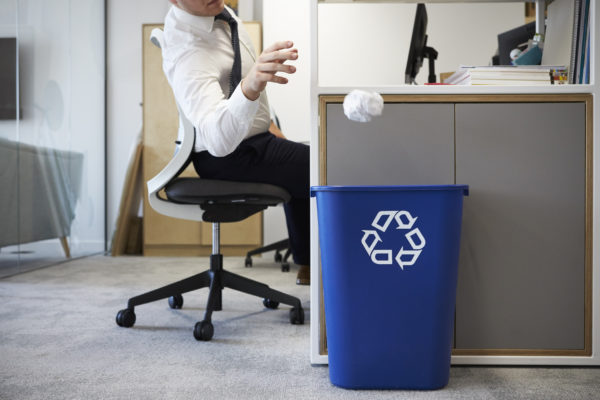
Updated: 5/25/21
What do these items–plastic water bottle, magazine, window envelope and soup can—have in common? First of all, you probably have each of these items somewhere in your office. But more importantly, all of these items can be recycled in an office recycling program.
You’re doing a great job of recycling at home. You’ve got the kids trained to rinse out all their cans. You’ve finally gotten your spouse into the habit of breaking down those cardboard boxes and stacking them near the recycling cart instead of tossing them. Now why not extend that green behavior to the workplace? For some of you, it may be because you don’t have a recycling program at work. But that doesn’t mean you can’t start one. Follow these steps to begin a recycling program:
- Find a champion—Every project needs a leader. Ideally, this should be someone who feels passionately about recycling and has enough time to manage the program (or at least enough time to delegate). Sharing the responsibility for the program is fine, but one person should be the main cheerleader or it will difficult to get the program off the ground.
- Audit your trash—Digging through the garbage might not be your idea of fun, but it will help you get an idea of the volume of recyclables that are going into the trash and what these items are. This will help with your planning.
- Figure out what to do with it—Granger offers several options for business recycling. If collection of your business’ recycling isn’t an option due to costs, service territory or other factors, consider taking your recyclables to a free drop-off center like Granger’s Recycling Drop-off Centers in Lansing and Jackson. You and your office mates can take turns dropping off recyclables!
- Place recycling containers around the office—Best practices say to put a recycling container anywhere you have a trash can, including at each employee’s desk. Inconvenient recycling containers can deter people from recycling, but if there’s a bin everywhere you go, it’s hard to find an excuse not to recycle. The containers don’t have to be fancy—just make sure they’re large enough to be practical and labeled appropriately.
- Educate, train and inform—Chances are, your coworkers want to recycle (and recycle correctly). They just might not know what or how to do it. That’s where the education comes in. Make a list of guidelines and post them in prominent places around the office (and near recycling containers). It’s helpful if your list includes items that should and should not be recycled. Include an office recycling brochure with your company’s new hire welcome packet. And don’t forget about the janitorial staff—if they’re not informed and trained, then there’s a chance your recycling efforts will go to waste, literally.
- Evaluate—After your program has been up and running for a while, figure out what’s working and what isn’t. It’s possible it will be perfect, with 100% participation and no contamination from the get-go, but it’s not likely. Look at ways you can build awareness and improve signage and training. If you’ve deemed your program a success, continue to grow it by adding specialty recycling collection days for non-traditional items like electronics or coffee pods.
